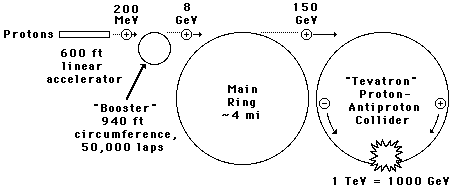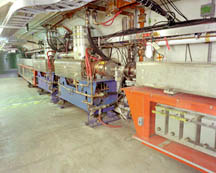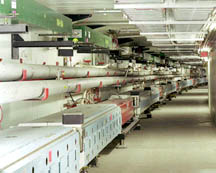Fermilab
The Fermi National Accelerator Laboratory near Chicago has the most powerful proton-antiproton collider, designed to reach 1 TeV. It is the only current facility which seems to have the power to produce evidence for the last of the quarks, the top quark.

Protons from the Main Ring in bunches of a quadrillion are smashed into a metal target to make antiprotons. About 10 billion are made and extracted into a triangular magnet array called an accumulator. Once a sufficient "stack" of antiprotons is accumulated, they are injected into the Tevatron. Six bunches of each type of particle, each bunch 2 ft long and thinner than a pencil, are accelerated in opposite directions around the ring to collide in a "shot" in the collider detector (Trefil,Discover Dec89, p56).
The Fermilab facility houses the Main Injector, a proton synchrotron accelerator. Beneath it in the same tunnel is another synchrotron, a superconducting magnetic ring called the Tevatron which boosts the energy to 1 TeV. There is an antiproton storage ring which achieves collision energies of about 1.8 TeV.
Before entering the Main Injector, protons are accelerated to about 750 keV by a Cockroft-Walton accelerator, then to about 400 MeV by a linear accelerator. They are raised to 8 GeV by a comparatively small booster accelerator and then up to 150 GeV by the Main Injector.
Associated with the Tevatron are two large detector facilities, the Collider Detector Facility and the D0 detector facility.
| Some discoveries at Fermilab |
|
| Accelerators |
Particle concepts
Search for elementary particles

Fermilab
| HyperPhysics***** Quantum Physics | R Nave |

